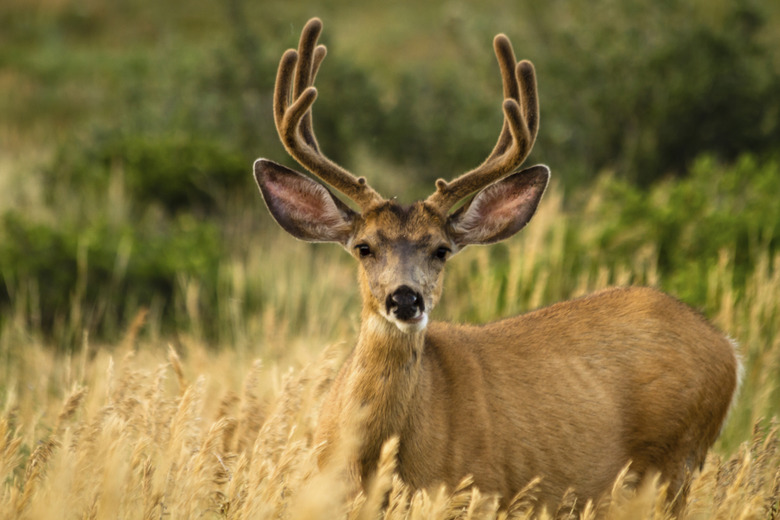What Kind Of Deer Live In Northern California?
If you find yourself in northern California, you might run across one of a few California deer species or subspecies. Three different species in the deer family, also known as the Cervidae family, range within the state of California. Of those three species, only two are naturally occurring native deer. Humans introduced a third species to a few isolated locations across the state.
What Kind of Deer Are in California?
What Kind of Deer Are in California?
You can find three species of deer in California: the mule deer, the elk and the fallow deer. Mule deer and elk are the only native California deer species. A handful of non-native populations of fallow deer also live in a few small populations across California. Though not a species native to the state, white-tailed deer also occasionally wander into California. However, white-tailed deer sightings are an unusual occurrence.
Mule Deer in California
Mule Deer in California
The mule deer is the most common species of deer in California. Six different subspecies live within the state: the California mule deer, desert mule deer, southern mule deer, Rocky Mountain mule deer, Inyo mule deer and the Columbian black-tailed deer. Several of these subspecies range into northern California.
California mule deer live west of the Sierra Nevada and down the southern coast. Desert mule deer live in the southwest region of the state. Southern mule deer live only at the southern tip of California. Rocky Mountain mule deer live in the northwest region of California. Inyo mule deer live exclusively in the Sierra Nevada. Finally, black-tailed mule deer range throughout northern California.
Hunters and researchers have spotted the closely related white-tailed deer on occasion in the northernmost regions of California. However, they do not naturally range into the state and sightings remain extremely rare.
Elk in California
Elk in California
The only other native member of the Cervidae family, three different subspecies of elk live throughout California. The Tule elk, Roosevelt elk and Rocky Mountain elk make up the three recognized subspecies. Most of their population resides in the northernmost reaches of the state. However, some populations range into the eastern portions of central California.
California Department of Fish and Wildlife has undertaken reintroduction efforts with this species. Elk previously ranged throughout wider expanses of California, and the CDFW has assessed regions within their historic range for reintroduction efforts. The program has relocated over 1,200 elk since 1975. Through relocation and conservation efforts, populations of the Tule subspecies alone have increased tenfold since the 1970s.
Non-native Deer in California
Non-native Deer in California
The final California deer species is the fallow deer. However, fallow deer do not naturally occur in California. Five individual introduced populations exist within the state. You can find these populations at the Point Reyes National Seashore in Marin County, Ridgewood Ranch in Mendocino County, Pomponio Creek in San Mateo County, in close vicinity to the Eel River in Trinity County and at the Hearst Ranch in San Luis Obispo County.
Each introduced population has its own history. For example, the Point Reyes Seashore population originally came from the San Francisco Zoo. A local landowner purchased the deer from the zoo in the 1940s, eventually releasing them into the area. Introduced wildlife can adversely impact native species by transmitting disease and competing with them for naturally occurring resources. The National Park Service controls the populations of introduced fallow deer and monitors their potential impact on native wildlife.
Fallow deer aren't the only non-native species to establish wild populations in California. Up until 2009, a population of axis deer also lived within the Point Reyes National Seashore. The National Park Service has since removed all axis deer and implemented long-term contraceptives on the remaining populations of fallow deer to prevent further population growth.
References
- California Department of Fish and Wildlife: Deer
- United States Forest Service Fire Effects Information System: White-Tailed Deer
- California Department of Fish and Wildlife: Elk
- National Park Service: Non-Native Deer
- iNaturalist: Columbian Black-Tailed Deer
- California Department of Fish and Wildlife: Life History Account for Elk
- California Department of Fish and Wildlife: Mule Deer
Cite This Article
MLA
Zinni, Yasmin. "What Kind Of Deer Live In Northern California?" sciencing.com, https://www.sciencing.com/kind-deer-live-northern-california-8773100/. 30 September 2021.
APA
Zinni, Yasmin. (2021, September 30). What Kind Of Deer Live In Northern California?. sciencing.com. Retrieved from https://www.sciencing.com/kind-deer-live-northern-california-8773100/
Chicago
Zinni, Yasmin. What Kind Of Deer Live In Northern California? last modified August 30, 2022. https://www.sciencing.com/kind-deer-live-northern-california-8773100/
